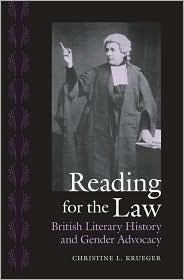The first is READING FOR THE LAW: BRITISH LITERARY HISTORY AND GENDER ADVOCACY (University of Virginia Press, 2010), by Christine L. Krueger (Marquette University).
Here's an excerpt from the publisher's summary:
Taking her title from the British term for legal study, "to read for the law," Christine L. Krueger asks how "reading for the law" as literary history contributes to the progressive educational purposes of the Law and Literature movement. She argues that a multidisciplinary "historical narrative jurisprudence" strengthens narrative legal theorists' claims for the transformative powers of stories by replacing an ahistorical opposition between literature and law with a history of their interdependence, and their embeddedness in print culture. Focusing on gender and feminist advocacy in the long nineteenth century, Reading for the Law demonstrates the relevance of literary history to feminist jurisprudence and suggests how literary history might contribute to other forms of "outsider jurisprudence."And here's a taste of the review, by M. Kelly Carr (University of Baltimore):
Much of her book is spent evidencing the complicated role of narrative in legal thought and discourse, including: evolving Victorian literary standards such as omniscient narration and realist fiction; the emergence of witchcraft as an evidence-sparse crime reliant upon narratives for conviction; epistemological shifts from romanticism to realism both in literature and the law; government agencies whose primary task was to listen to stories of people [*338] incarcerated in insane asylums; and the use of “cover stories” to shelter certain crimes from prosecution. These uses of narrative range from mildly emancipatory and agency-building to fairly ineffective, and her analysis is always tied to larger social, political, and gender histories that pleasantly blur the causal lines sometimes drawn by comparative scholars. In several chapters, Krueger takes to task feminist advocates who would use narrative jurisprudence as an “antidote” to masculinist modes of reasoning, reminding readers that “no mode of representation enjoys special powers of advocacy” (p.51). Rather, literary techniques earn critical treatment because they are just as culturally bound as are legal processes; literary treatment is not “an autonomous aesthetic subject, but is itself historically contingent” (p.51). Krueger shows that a deeper investigation of the interrelations between literature and legal discourses, while carefully considering the historical context in which they acted, can help us understand both the limitations of specific attempts at “outsider advocacy” and to find evidence of those attempts, within literature, that are not represented in formal legal discourse.The full review is available here.
The second book is THE END OF INEQUALITY: ONE PERSON, ONE VOTE AND THE TRANSFORMATION OF AMERICAN POLITICS (W. W. Norton and Company, 2008), by Stephen Ansolabehere (Harvard University) and James N. Snyder (MIT).
There's not much to see on the publisher's website, but reviewer Christopher Malone (Pace University) offers a concise summary of the argument.
THE END OF INEQUALITY focuses on the “quiet revolution” which occurred in the four decades after the landmark BAKER v. CARR decision of 1962. According to Ansolabehere and Snyder, BAKER v. CARR presents the political scientist with the closest thing to a “natural experiment” (pp.13-18) one could find in the political world. For the first five decades of the twentieth century, most state legislative districts across the country remained apportioned in accordance with the precepts, population and power structure of a rural/agrarian society. By the 1960s, however, the United States had become a predominantly urban/suburban society; population had shifted to metropolitan areas but political power had not followed. BAKER v. CARR, and the ensuing cases, would change the malapportionment of state legislative districts all across the country with an elegantly parsimonious phrase: one person, one vote. For Ansolabehere and Snyder, this sets up a perfect political experiment – a before and after scenario rarely available in American politics.
Have the equal rights announced in BAKER v. CARR and its progeny led to equitable outcomes? . . . .
In brief, the answer for Ansolabehere and Snyder is an unequivocal yes: “the effects of reapportionment [in the wake of BAKER v. CARR] on these different aspects of politics all point to a singular conclusion: equal votes mean equal power. The equalization of representation led directly to an equalization of the distribution of public expenditures – who got what” (p.15).As Malone notes, this is a book in the Gerald Rosenberg tradition: it explores whether the courts can and should bring about social and political change.
The full review is here.

